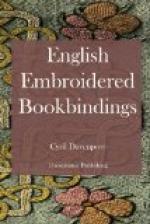Probably enough no proof of their having been worked by Elizabeth will now ever be forthcoming, but it is equally unlikely that any positive disproof will be found.
The two ‘Elizabeth’ books stand alone—there are no others resembling them; but the next kind of embroidered work I shall describe is one which includes a large number of books, generally small in size, and usually copies of the Bible or the Psalms. The canvas in these cases is embroidered all over in small tapestry-stitch, the design being shown by means of the different colours of the silks used. The work being all flat it is very strong, and often books bound in this way are in a marvellous state of preservation. The most interesting designs are those which represent Scriptural scenes. Some of these are very curious and almost grotesque, but there is much excuse for this. To work a face any way in embroidery is troublesome enough, but to work it on a small scale in tent-stitch is especially difficult, the result being somewhat similar in effect to that of a glass or marble mosaic, each little stitch being nearly square and of an uniform colour. The designers of these embroideries do not appear to have had a very fertile imagination, as again and again the same subject is represented. Perhaps the most favourite of all is Jacob wrestling with the angel; of figure subjects ‘Faith and Hope’ are the most frequently met with, but ’Peace and Plenty’ are also common enough.
[Illustration: 6—Christian Prayers. London, 1581.]
Christian Prayers. London, 1581.
A Book of Christian Prayers with illustrated borders, printed in London in 1581, is bound in coarse canvas worked in tapestry-stitch in colours, and measures 7 by 5 inches. The same design is on each side—a kind of flower-basket in two stories, out of the lower part of which, rectangular in shape, grow two branches, one with lilies and another with white flowers, and out of the upper, oval in shape, rise two sprays of roses, one white the other red.
In the lower corners are a large lily, a blue flower, and a large double-rose spray. All the design is outlined with silver cord or thread, and the veinings of the leaves are indicated in the same way. There are remains of two green velvet ties on the front edges of each of the boards. The back is not divided into panels, but has a design upon it of the letters E and S repeated five times. The edges are gilt and gauffred.
Psalms and Common Praier. London, 1606-7.
During the seventeenth century little ‘double’ books were rather favourite forms for Common Prayer and Psalms especially. These curious bindings open opposite ways and have two backs, two ornamental boards, and one unornamented board enclosed between the two books, which are always of the same size.
There are several instances where embroidered books have been bound in this way, the earliest I know being a copy of the Psalms and Common Prayer, printed in 1606-7.




